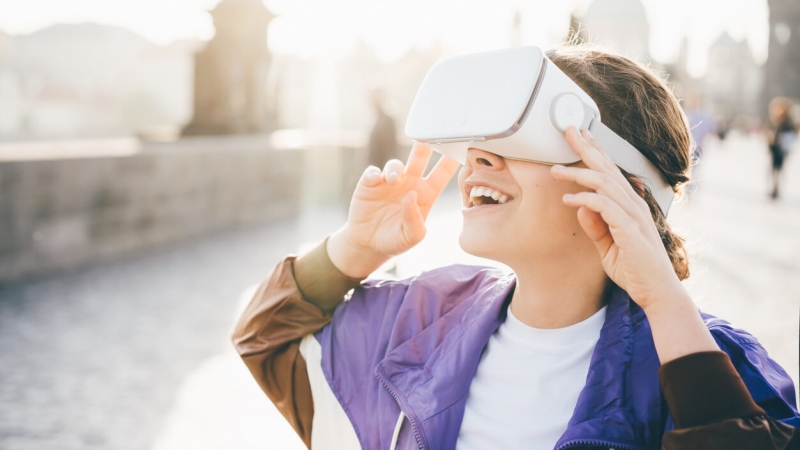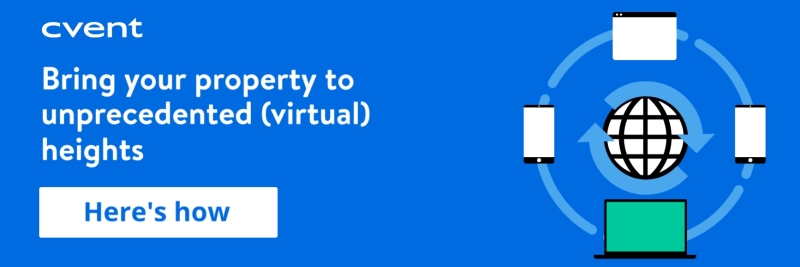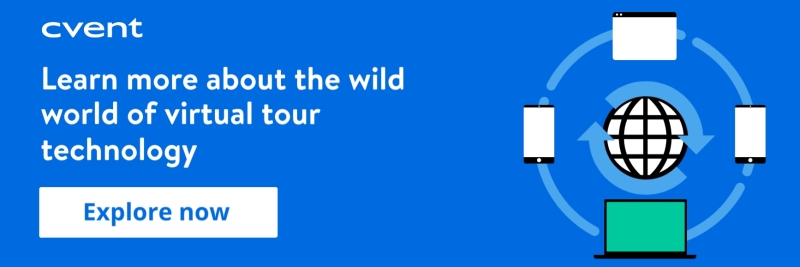With the COVID-19 pandemic limiting where people have been able to go over the past couple of years, hotels, destinations, and travelers alike have felt the effects.
However, creative marketing and new virtual offerings can make a big difference in the years to come. Virtual tourism and travel are taking off, and hotels and destinations that know how to capitalize on the trend will set themselves up for success as the world returns to normal and more and more travelers once again pack their bags.
Take a look at our expert advice below to learn all about virtual tourism and the benefits it can offer. Plus, explore examples from some of the top virtual tourism campaigns across the world.
What is virtual tourism?
Virtual tourism presents viewers with an immersive experience of an activity, location, or destination through the use of technology. There are tons of different types of virtual tourism offerings, but there's usually a combination of virtual reality, still images, video, audio, narration, interactivity, and other multimedia formats to provide an experience of a destination that a user cannot get through images or websites alone.
Viewers can access virtual tourism content using a virtual reality headset for the most immersive experience, but they can also usually view the content on a normal computer or even a mobile device.
What are the benefits of virtual tourism?
Because viewers can experience activities, locations, and destinations from the comfort of their own homes, there are many clear benefits to virtual tourism. The most obvious of these benefits is that viewers can see and experience a destination without traveling to it, which means they aren’t limited by available flights, travel logistics, safety concerns, and whether destinations are open. They don’t even have to think about time zones or weather conditions.
The other huge benefit for viewers is cost. Virtual tourism makes destinations accessible to millions of people who may otherwise not be able to afford to travel to them. Viewers are embracing the rise in virtual tourism destinations and the increasing quality and availability of virtual reality technology to see and experience things they never thought possible.
For hotels and destinations, the clear benefit is the ability to stay top-of-mind with potential customers and to highlight a location, amenities, and offerings. Viewers who have experienced a hotel or location through virtual tourism are more likely to book a future stay, and will eagerly anticipate experiencing the activity in the “real world.”
There are also great marketing opportunities offered by virtual tourism technology. Potential guests can see a 360-degree view of a property and its amenities, rather than the flat images on a brochure or website. Experiencing a property this way increases the chances that viewers will want to visit in the future, and means that they can easily share the virtual offerings with their friends and family.
And that’s not all. Virtual tourism has a handful of other benefits:
- The immersive experience allows the viewer to imagine themselves at a travel destination.
- The viewer can control what they see of a destination, experiencing 360 degrees of a location.
- All aspects of a destination can be showcased in high resolution.
- Hotels, Convention and Visitors Bureaus (CVBs), and travel agencies can stand out from the crowd.
- The impact of tourism on vulnerable destinations is reduced.
How is virtual tourism used?
There are lots of great ways for hotels and destinations to take advantage of this technology and the demand for virtual tourism, and it goes well beyond COVID-19.
CVBs have been using virtual tourism for years to highlight the unique aspects of a location, including everything from history and culture to exciting activities, local attractions, and fun trivia.
Hotels, CVBs, and local governments use 360-degree VR video to capture everything about a destination in an immersive way. This lets viewers experience a remote mountaintop, an idyllic beach, a network of hiking trails, or a buzzing city with the press of a button.
VR photography, on the other hand, captures still images and pieces them together using specialized software, creating an immersive image where a user can look in any direction. This technology is great for showing hotel interiors, artwork, museum exhibits, and anything that can be fully experienced without motion or sound.
Finally, fully immersive VR experiences let users get in on the action, interacting with the environment and discovering more through their actions. This is often a curated experience focusing on one aspect of the location, like the food scene, music, history, or art. Virtual reality yoga classes, nature walks, stargazing, and bird watching have all become popular ways for a location to show off everything it has to offer.
What are some examples of virtual tourism?
Below are a handful of our favorite virtual tourism campaigns from across the world. While each campaign offers something different, the common theme is that each one was created to give users easy, safe, and interactive access to a location.
The Faroe Islands
The Faroe Islands created a virtual tourism campaign once COVID-19 began to give people an alternative option to traveling to the location.
"Early on in this global crisis, we sat and wondered how we could recreate a Faroe Islands’ experience for those who had to cancel or postpone their trip to the Faroe Islands – and for everyone else stuck in insolation around the world," reads the virtual tourism segment on Faroe Islands' website. "We had an idea. What if we could allow people anywhere in the world to explore the islands as virtual tourists through the eyes of a local? Or even better; what if the virtual tourists could control the movements of the local in real time?"
Bristol From Home
Similar to the Faroe Islands, Visit Bristol (England) created an immersive experience due to the COVID-19 pandemic. Bristol From Home features a collection of travelers' favorite ideas, inspirations, and resources "so that you can continue to enjoy Bristol, during social distancing measures, from the comfort of your own home."
The website features a myriad of virtual options, including tours of a luxury Victorian ship, hot-air balloon rides, gin tastings, and much more, all in one place.
Dubai 360
Tour the awe-inspiring architecture of Dubai with Dubai 360 — an immersive virtual tourism experience that allows users to travel the city through a bird's-eye view and learn all about the locations scattered throughout.
"Our services help increase online presence, which is crucial to marketing anything in the present," reads Dubai360's website. "We aim to raise you above your competition by presenting a professional and high quality look, and improving your customers' first impressions. This service is equally useful for Hotels, Restaurants, Malls, Real Estate, or anything that can be presented visually."
Great Barrier Reef
Yes, even the Great Barrier Reef has virtual tourism offerings. The interactive journey is headlined by legendary broadcaster and historian, David Attenborough, who takes viewers throughout the world's largest coral reef system. This is much more than simply a replacement for Great Barrier Reef tours — it's an experience in and of itself, and it showcases just how versatile virtual tourism can be.
What does virtual tourism mean for the hospitality industry?
Virtual tourism is one of the many keys to the travel industry’s resilience and ability to bounce back from an unprecedented time. Showcasing everything that a property or destination has to offer is a great way to build excitement for “normal” travel and keep the destination top of mind once travelers are able to vacation again.
Virtual tourism has been lauded as a way for hotels and destinations to highlight the intangibles of their location, capturing the special feel of the place and drawing interest from travelers who might not otherwise consider it.
"A true gift of virtual travel is that we can safely and efficiently access experiences we've always wanted to access," Dennis Watkins, owner of The Magic Parlour in Chicago, said in an article for marthastewart.com. "People separated by oceans can look each other in the eyes and share stories, cultures, and ideas. When I do a show for a single family who logs in from London, Leeds, Norway, or Chicago, I start to see the power of the virtual space ... and I think we're just now starting to understand and leverage that power."
How can hotels capitalize on the virtual tourism trend?
To strategize how best to use virtual tourism, hotels should go back to the basics of their hotel marketing plan. What audience are you trying to reach? What amenities, offerings, or features make your hotel and its location unique and interesting? What aspects of your property or destination do you want to highlight? The answers to these questions will form the foundation of your virtual tourism offerings.
If you have a few experiences that guests return for time and time again, these are a great place to start with your virtual tourism experience. Give viewers a tour of your on-site vineyard, sandy beach, art deco decor, or spectacular views.
Because you can create many different virtual reality experiences, you can craft custom offerings for all of the different types of guests who stay at your property. A street art tour may be a perfect fit for young adult travelers, while an immersive symphony orchestra performance may be perfect for older guests. Try creating three or four experiences targeting guests who you would like to see at your hotel in the future, and follow through on the virtual experiences with custom packages, content marketing, and targeted informational emails.
As you craft your unique virtual tourism offerings, keep in mind that this medium isn’t limited to the traditional perspective with which your guests normally see your destination. With virtual tourism, guests could fly over your property in a hot air balloon, swim in your lake without getting wet, ski down to sit by a roaring fire in your lobby, or zip-line through the trees. By adding experiences that guests may not be able to get in person, you’ll move beyond the idea of replacing "real" travel.
Additionally, hotels can use the virtual tourism boom to appeal to planners and their event attendees as well. Not all offerings have to be limited to guests. Do you have a breathtaking ballroom with a state-of-the-art A/V system? What about extensive meeting space in your beachside bungalows? Utilize innovative 3D technology to create a virtual experience highlighting what sets you apart and creating demand.
In other words, the sky really is the limit when it comes to virtual tourism offerings. If you can think of an experience in the real world, you can likely recreate it in some fashion through virtual reality.
Now you know all about virtual tourism!
Bookmark our blog to stay up to date on all the trends and happenings from throughout the hospitality industry, as well as high-level overviews, industry-leading tips and advice, and much more.





